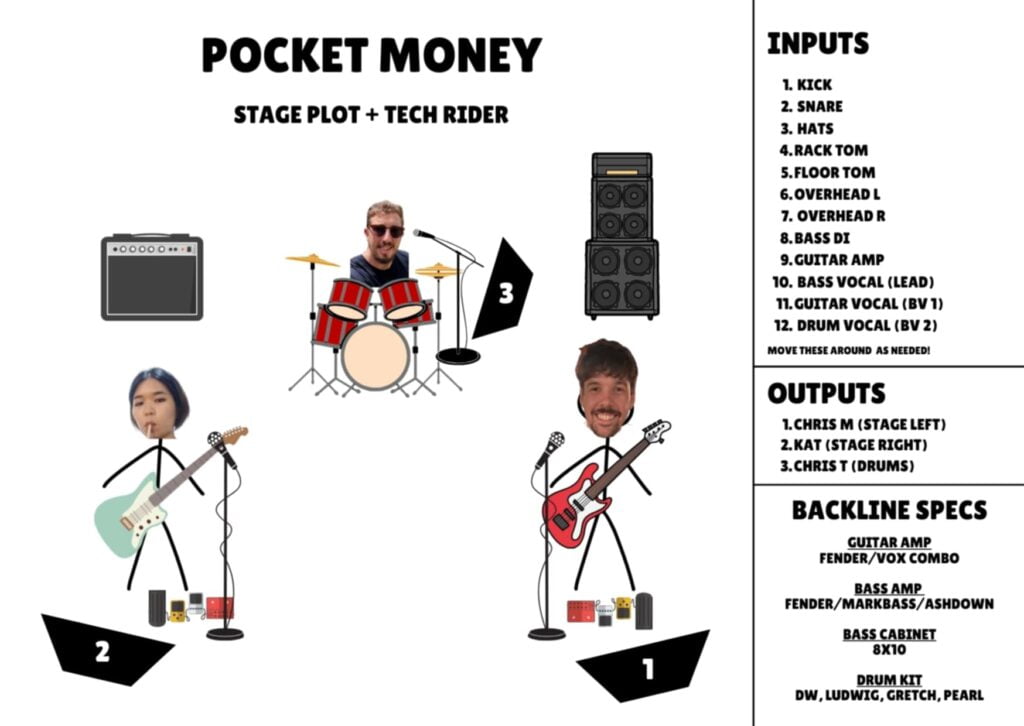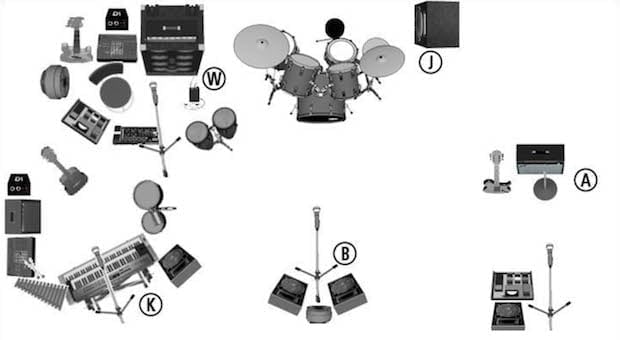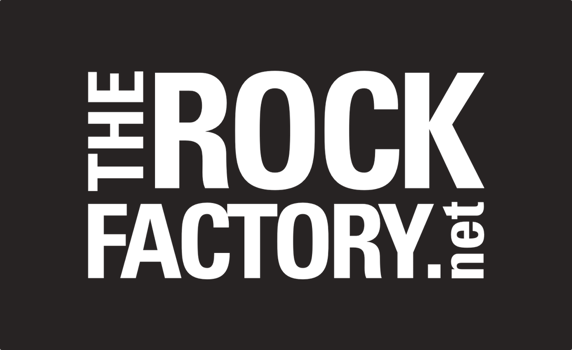To ensure a successful performance, artists, performers, bands, theatre productions and event organisers should use a technical rider. This document serves as a way to communicate the technical requirements between the band or artist or theatre show and the venue, promotor or event organizer.
The technical rider is then given to the production hire company, like the Rock Factory, and we ensure everything on it is provided at the gig. A well-crafted technical rider can prevent misunderstandings and last-minute surprises. It should include in detail the ideal setup that the band or performing group wants, which may be open to some negotiation. However, any adjustments or substitutes must be discussed with the band, director, cast or performers well before the event.
Pictures speak a thousand words, so here is an example of a tech spec we love! Its simple and has the basics of the info that a production company would need to figure out what to provide for the band. Chris, our technician who is a member of the band created the tech spec for this band in CANVA. I’ll often use a spreadsheet to list my inputs and provide information next to the table to clarify anything. Others use word, Google Docs or other similar programs. The one page rider below is a good example of how you can get a lot of info into one page! Tech riders come in all sorts of sizes from 1 page to 15 is probably the most I have seen! It depends on how large the production, event or concert is and how picky the band or entertainer is going to be.

What are the Primary Components of a Technical Rider?:
What do you need to perform? Include your Minimum FOH PA System, Mixing Desk and Foldback Monitoring Requirements:
To ensure a successful performance, please provide specific details when requesting equipment.
It’s best to list your sound system preferences by name, such as d&b audiotechnik, JBL, or dB Technologies Front of House Sound Systems. Alternatively, you can request a sound system that’s suitable for the venue’s maximum audience capacity and leave it to the Production Company to provide the appropriate system.
Make sure to specify your preferred foldback sizes (e.g., 15-inch foldback speakers), power requirements (a power board next to the lead singer is a must), microphones (we prefer Shure or Sennheiser microphones, but you can choose what you think is best), and crew members needed, such as a FOH live sound engineer, monitoring engineer, lighting operator, and backline technician.
You may also have specific requests such as drum risers, DI boxes, lighting requirements, or props. The team will be better equipped to fulfil your requests if they are more detailed and actionable.
If you’re traveling with a FOH technician, they might have a preferred mixing desk that they can load an existing show file onto, so please include this information as well.
Who is the best Contact for the Band to discuss Technical requirements?
This technical rider should detail the artist or band, their music genre, and specific sound requirements.
It should include contact information for band members or a designated contact person, names and roles of band members, and where to find audio samples or relative references. For example, a good contact might be the band’s tour manager or front-of-house sound engineer. The Production company will likely call this person to verify information on the rider and discuss any substitutes or compromises, so it is important that this person is able to make those decisions for the band or performance group.
Please provide a diagram of The Stage Layout – A Picture Speaks a thousand words!
This can be hand drawn or created using a template or a online tool such as this stage plot creator on techrider.com.
The stage layout plan is a detailed depiction of where each performer will be on stage and what instruments they’ll be playing. It should also indicate where monitors should be placed and what should be heard on these monitors.
Listing all individual parts of the drum kit or other critical equipment if band backline is to be provided is also necessary.

Please Provide an Input and Output List in your Technical Rider.
Outlines how many and which channels the artist needs, detailing any special requirements for each channel. For example:
- The Kick drum requires a beta91 microphone placed inside the kick drum on a pillow that touches both the front and back skins of the kick drum.
- The snare requires a e904 clip on microphone on the top and another on the bottom that is phase reversed.
- The guitar amps require short microphone stands with sm57 microphones on them.
- The use of any in-ear or wireless systems, and their required frequencies, should also be specified
- The Production company will need to know how many foldbacks you need and if you require side fills or a separate output for a sub for the drum fold back.
- They will also need to know if you require a monitor engineer or
- Areyou are providing your own pre-configured IEM (in ear monitoring) system and need a stage split of all the inputs that are plugged in.
- All di boxes for the keyboard and tracks channels must be a reputable brand such as radial or bss.

What Equipment will be brought by the Artist or Performer?
When preparing for an event, it’s important to provide a detailed technical rider that outlines all the equipment you’ll be bringing. This includes microphones, stands, cables, in-ear monitoring systems, and instruments.
It’s also important to indicate which equipment is available for sharing with other performers, such as drum parts or amplifiers.
If you’re performing locally, you may provide your own backline, but for out-of-town or international gigs, you may need to rent equipment. Make sure to confirm with the production company what equipment you’ll be providing to ensure everything is covered.
If you have a specific brand sponsorship, communicate this with the production company so they can ensure the brand is represented, and any necessary equipment is obtained. This includes any must-use equipment, like sponsored microphones from Shure.
Artistic Notes for the Sound, Lighting and Visual Operators:
I’ve received excellent technical assistance from some riders who provided detailed notes on the desired atmosphere and aesthetics for their performance. Some songs require a specific colour wash to match the mood, or a strobe or blackout at a particular point in the performance.
Some artists have requested specific intro music or customised drum sounds, such as a Metallica-style kick or gated reverb on the snare. Others may want special effects on certain songs, such as dubbing out the last word of each chorus sentence.
Providing technicians with as much information as possible before the event ensures that the show reflects your vision.
If you plan on using visuals, make sure the VJ knows when to display specific images.
You may want to include links to videos of past performances that you liked, official music videos, or examples of photos or videos from gigs that you want to look similar to.
The Technical Rider can work as A Legal Contract.
A technical rider can also be a contractual document between the artist and the event organiser. It should state that it’s part of the performance contract and that any breach of the technical rider constitutes a breach of the contract. This provides a legal basis for dealing with issues if the organiser doesn’t fulfil the stipulated technical requirements.
When writing a technical rider, it’s crucial to be clear and specific about what is necessary for the performance. The perfect technical rider is concise, easy to understand, and unambiguous in its wording and requirements. If something is absolutely non-negotiable you might want to include this information for example “If requirement xyz is not met, there will be no show”
Summary of Technical Rider and Why it is Important:
In conclusion, a technical rider is a comprehensive document that serves as a bridge between the artist and the event organiser, ensuring a smooth and successful performance. By clearly outlining the technical requirements:
- It minimises the chances of misunderstandings and ensures that both parties are on the same page. When artists, performers, bands, or event organisers need to outline the technical requirements for a gig, they use a document called a technical rider.
- This document acts as a communication tool between the band or artist and the venue or event organiser.
- It ensures that all necessary equipment, stage setup, and other technical elements are in place for a seamless show.
- The promotor or event organiser hands the technical rider to the production company, like us at the Rock Factory, and we ensure that everything on the list is provided at the gig.
- A well-crafted technical rider can prevent misunderstandings and last-minute surprises or complications.
- A picture speaks a thousand words, including a stage plot and a table of inputs.
- The technical rider should provide detailed information about the ideal setup that the band or performing group desires.
- While there may be room for negotiation, any adjustments or substitutions must be discussed with the band well before the event.
Here is a really helpful video produced for Soundgirls on youtube that can help you create a stage plot and input list. BTW as a woman-owned business, the rock factory fully supports what soundgirls.org are doing to decrease the gender gap in the technical side of the music industry!
